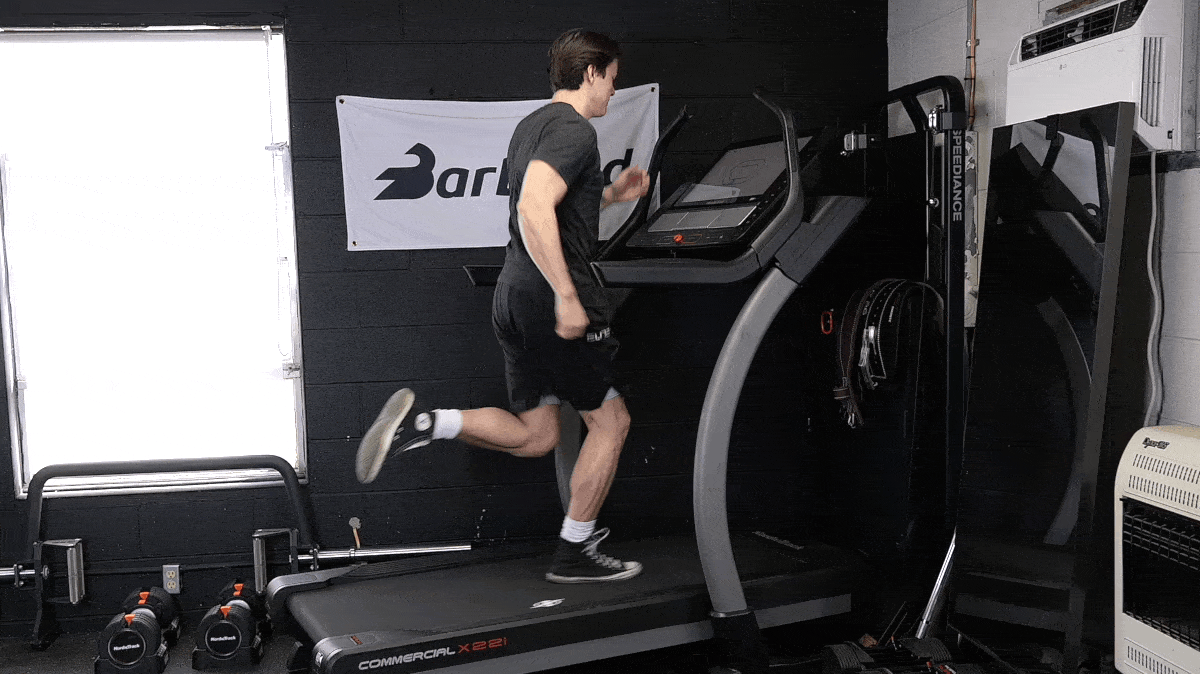There are many reasons to go for a run. If you’re like any of my clients, you might focus on improving your heart rate, aiming for a specific mileage, or maybe even relaxation after a long day at the office. Another popular goal of running is to get yourself more active while managing or changing your body weight.

Timing a run or measuring your distance isn’t particularly hard — you just need the treadmill, for example — but even with a fitness tracker, the number of calories burned during a run is a bit tougher to nail down. Energy expenditure is one of the most important equations for your body composition — so how many calories are burned running a mile?
How Many Calories Do You Burn Running a Mile?
People’s energy expenditure — how much energy, or “calories,” they’re using at any given time — depends on a lot of factors. Things like age, fitness level, weight, and running speed all impact how many calories you’re burning.
Someone running slowly, for example, will likely burn fewer calories than a similar person running faster. Why? Because going fast at a high intensity takes more energy than going slowly during your cardio workouts.
[Read More: The Best Treadmills with Screens, As Chosen by Our Experts]
However, your physical activity levels and running pace aren’t the whole story. Everyone’s body is different, so everyone’s got different metrics to attend to.
For example, a 140-pound person and a 180-pound person may burn calories at a different pace on the same run. Generally speaking, a person weighing more will burn more calories — use more energy — than a person weighing less.
Still, there are some averages and trends we can look for when trying to figure out a ballpark estimate for how many calories you might burn during a run.
One study from California State University aimed to measure the calories burned during a one-mile run compared to a walk. People with an average fitness level were recruited to make the comparison. (1)

[Read More: The Best Treadmills for Heavy People]
It was found that running a mile burned on average about 115 calories compared to roughly 89 calories for walking. It should be noted that there was a degree of variability between participants, as the average running calories had a range of 115 calories plus or minus 24 calories. (1)
Another interesting note is the amount of calories burned during the recovery period afterward. Seemingly because of the increased intensity during running compared to walking, more calories were also burned after the fact. Running, for example, burned on average nearly 45 additional calories while resting compared to just 22 calories post-walk. (1)
What Is a Calorie?
A calorie is a unit of measurement for energy like degrees Fahrenheit are a unit of measure for temperature. Specifically, a calorie is the amount of energy required to raise the temperature of one liter of water by one degree Celsius. This means that more calorically dense foods would therefore provide more energy
What Factors Influence Calorie Burning During a Run?
Several unique factors from person to person influence how many calories are burned during a run.
- Age: Increased age tends to be associated with slowly decreased energy expenditure, with older individuals burning less on average than younger individuals.
- Gender: Cis men may burn more calories on average than cis women due to several reasons such as body size or body composition. Hormone levels, including hormone replacement therapy for trans and nonbinary athletes, may also impact this.
- Weight: Body mass plays a role in calorie expenditure by adding physical resistance during our runs or more active tissue at play. In general, people who weigh more tend to burn more calories than people who weigh less.
- Terrain: Terrain such as hills or slopes affect how challenging the run is, adding calorie burn along with them.
- Pace: Running at an increased pace needs a greater calorie burn than running at a slower pace in the same amount of time because it takes more energy. More strides during our run by using a faster pace results in more energy consumed.
- Running Technique: Running technique is a bit of a double-edged sword. Improved running technique means increased movement economy. As a result, the amount of energy we consume per run may decrease with improved skill.
Calorie Calculator
Although many factors affect the final total of calories burned during a mile run, these estimates can be a powerful tool in achieving your body composition goals. Treadmills often use calorie expenditure calculators that take into account our body weight to give a much more accurate guess.
But it’s not all about the calories — or energy — you’re using on the treadmill. It’s also about how many calories — aka, how much energy — you’re fueling your body with in the kitchen.
[Read More: The Best Weight Loss Programs for Women]
You’ll need to make sure that you’re fueling your runs with enough energy, so getting a general estimate of how many calories you need to consume each day can help you along. Using a calorie calculator like BarBend’s can help you balance your running with any goals of bulking up, losing weight or maintaining your current weight.
Calorie Calculator
[Read More: Expert Tested: The 10 Best Cushioned Treadmills on the Market]
Benefits of Running a Mile
Running a mile has numerous benefits that extend far beyond burning calories and any potential impact on weight loss. Whether you’re running a half-marathon under the tutelage of a running coach or are doing some low-impact cardio to benefit your strength training, you’ve got an assortment of health benefits waiting at the finish line.
Resting Heart Rate
Cardiovascular fitness is a huge factor in overall health. Fortunately, you don’t need to completely re-invent your training program to make improvements to your resting heart rate. Although more cardio training would improve your results even further, getting started with simply running a mile is a relatively easy win here.
[Read More: How Many Steps in a Mile?]
Your resting heart rate is a measure of how hard your cardiovascular system needs to work to keep up while you’re just relaxing. Running a mile every once and a while is a time-efficient way to stay on top of your resting heart rate goals and overall cardiovascular fitness.
Aerobic Base
Running a mile is a short enough distance and time commitment that it is often relatively easy to sneak into your routine. Whether as a workout cool-down, warm-up, or its own standalone session, running a mile is a great way to establish a base of aerobic fitness.
[Read More: Expert Tested: The Best Treadmills for Running]
Given the positive impact aerobic training has on metabolic health and wellness, this is a huge opportunity to stay on top of your heart health and to set the stage for any future aerobic goals. Completing a 10K race, anyone?
Pace Goals
Goals are a powerful way to improve performance. Tacking on a specific target to a workout directs your focus and increases effort. A pace goal for running a mile is a clever way to keep improving without having to create big waves in programming. Simply aiming for a 10-minute mile to chip away down to a nine-minute mile is enough to encourage effort and results.
Frequently Asked Questions
Now that we’re entertaining the idea of a bit more running in our lives, here are some frequently asked questions about running a mile.
How many calories does a two-mile run burn?
Given the estimation that running one mile burns approximately 115 calories (1), let’s assume that two miles burns about 230 calories. However, it’s worth noting that each person has an individualized calorie expenditure per run based on body size, running technique, or many other factors.
How many calories does a one-mile walk burn?
A one-mile walk burns approximately 89 calories when measured by average fitness level research participants. (1) Similar factors influence calories burned during a walk as they do during a run, for example, body size, age, and others.
How many calories does a 30-minute run burn?
Running for 30 minutes may burn anywhere from 280-520 calories, according to the American Council on Exercise. (2) It should be noted however that these numbers are estimates. Body size, mile pace, terrain (incline or decline), and many other factors influence the exact number of calories we burn in 30 minutes.
How many miles do you need to run to burn 500 calories?
Based upon one study from California State University investigating the average number of calories burned during a mile run, it likely takes between four to five miles to burn 500 calories. The study showed that an average fitness level participant burned about 115 calories per mile. (1) Dividing 500 calories by 115 per mile lands us between four and five miles total.
References
- Wilkin, L. D., Cheryl, A., & Haddock, B. L. (2012). Energy expenditure comparison between walking and running in average fitness individuals. Journal of strength and conditioning research, 26(4), 1039–1044.
- Walsh, Grace. (2023) How many calories does running burn? It’s probably more than you think. ACE Fitness.